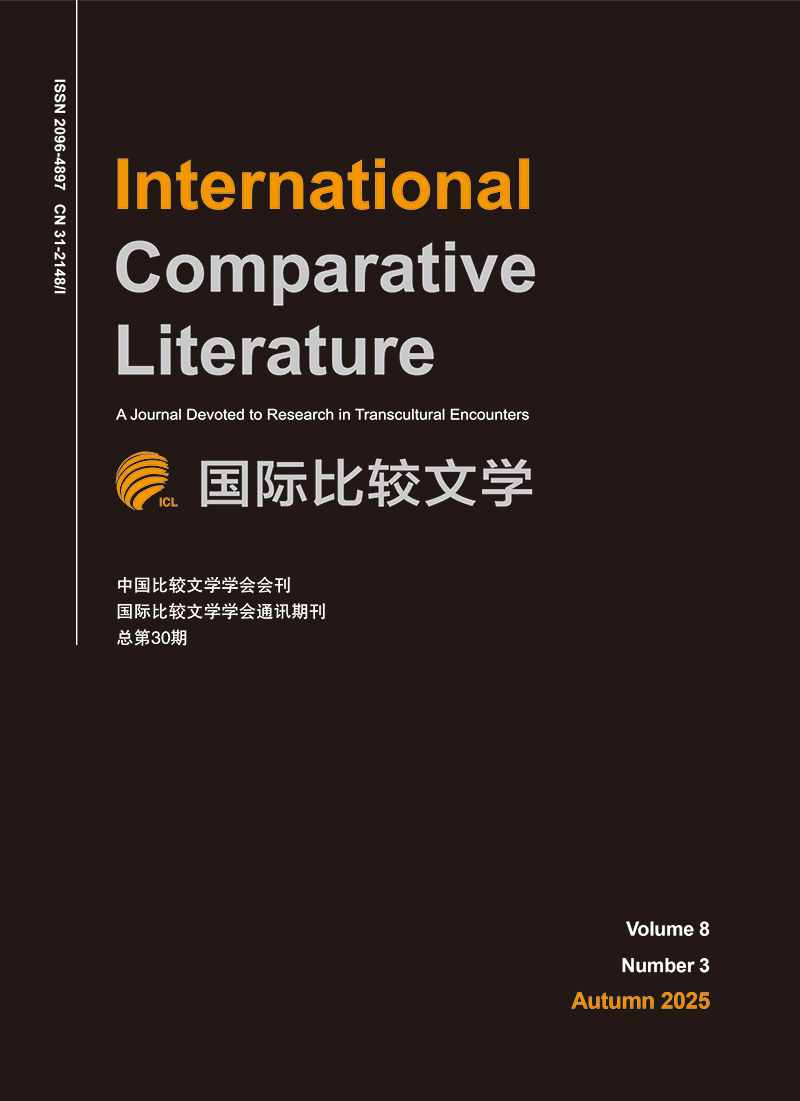Group Identity and Urban Writing of Chinese Intellectuals Who Studied in France:Taking Hsu Sung-Nien’s Literary Works as an Example
-
摘要: 徐仲年作为中法文教交流合作下培养的中国新一代知识分子,既吸收中华传统文化的经验,又受到法国文化启蒙精神的熏陶,形成了汇通中西的学思观。他是里昂中法大学第一批留法学生,在完成知识分子身份建构、实践社会责任的同时,留下了丰富的原创作品。不同于参与赴法勤工俭学的社会改革人才,徐仲年作为启蒙知识分子,其作品具备明显的写实主义、自叙传风格以及“双城”书写特点,其文本内容和交往行为体现出他追求社会启蒙和文艺自由的理念,以及他因对异国文化、道德、文艺的高敏感性而始终承受的情感和精神焦虑。徐仲年在法国完成知识分子的身份转型,这期间他利用文艺创作和沙龙活动满足自己的情感需求,法兰西文明的启蒙主义价值观培养了他崇尚实干的精神。归国后他继续通过城市书写寄托情感,履行知识分子的社会责任,一方面传播文艺和科技领域的新成果,另一方面批评现代城市文化的荒凉,反对新文艺的功利化。一·二八事变后,徐仲年以写实主义的文艺创作参与抗战文艺动员,以批判性视角记录了上海、重庆等地的城市生活与文化细节。抗战胜利后他投身于上海文化界重建中。徐仲年的城市书写体现出其对现代知识分子群体强烈的身份认同,以及对中法文化的有机结合,是为观察民国留法知识分子思想世界的范例。Abstract: Representative of a new generation of Chinese intellectuals cultivated under Sino-French cultural and educational exchanges, Hsu Sung-Nien not only absorbed experience from traditional Chinese culture, but was also influenced by the spirit of the Enlightenment in French culture, shaping his unique perspectives on learning and thinking that integrate both Chinese and Western visions. He is among the first cohort of overseas students to study at the Lyon Sino-French Institute in France. While completing the construction of his intellectual identity and practicing social responsibility, he was also a prolific author of original literary works. Unlike the reformist students who participated in the work-study program, Hsu, as an intellectual of the Enlightenment, mainly produced writings that feature realism, autobiographical style and writing characteristics exclusive to the “twin cities” (i.e. Shanghai and Paris). The content of his literary work reflects his pursuit of social enlightenment and literary freedom, as well as his high sensitivity to foreign cultures, morality,literature and art, which always leads to emotional and spiritual anxiety. Hsu Sung-Nien accomplished the transformation of his intellectual identity in France, where he met emotional needs primarily through artistic creation and literary salons, and the Enlightenment values in French culture cultivated his tendency to advocate practicality. Upon his return to China, he continued to express his feelings through urban writing, fulfilling his social responsibility as an intellectual. On the one hand, he made a considerable contribution to disseminate new literatures and technologies. On the other, he also criticized the urban desolation in modern culture and disapproved of the utilitarianism in new literature and art. After the January 28th Incident, Hsu Sung-Nien participated in the mobilization of anti-Japanese resistance art through realistic literary creation, which recorded the details of urban life and culture in Shanghai, Chongqing and other places from a critical perspective. After China’s victory in the Anti-Japanese War, he devoted himself to rebuilding Shanghai's cultural circles. Hsu Sung-Nien’s urban writing demonstrates his strong identification with the modern intellectual community and his endeavor to organically combine Chinese and French cultures, serving as a typical example for observing the thoughts of young intellectuals in that era.
-
Key words:
- study in France /
- intellectuals /
- group identity /
- urban writing /
- Hsu Sung-Nien
-
[1] .段怀清《中法大学:文学、人文教育及文科生》,《中山大学学报(社会科学版)》2021 年第5期。 [2] .郭绪印《旧上海黑社会》,上海人民出版社,1997年。 [3] .记者《作家卖字捐稿劳军》,《抗战文艺》1941年第7卷第2/3期。 [4] .金星《别一种“生活的艺术”——周作人1933 年至孙福熙手札一通》,《鲁迅研究月刊》2015年第10期。 [5] .梁海军《徐仲年与鲁迅作品的法译》,《法国研究》2018年第3期。 [6] .李喜所主编《留学生与中外文化》,南开大学出版社,2005年。 [7] .上海文艺作家协会研究组主编《上海文艺作家协会成立纪念册》,上海文艺作家协会秘书室,1947年。 [8] .苏智良《上海黑帮》,上海辞书出版社,2010年。 [9] .王进珊《王进珊选集》(上),文化艺术出版社,2000年。 [10] .万振凡、何金华《离乱余年:抗战时期内迁知识分子的心态衍变——以后方教授群体为中心》,《重庆师范大学学报(社会科学版)》2022年第1期。 [11] .许杰《现代小说过眼录》,立达书店,1945年。 [12] .徐书珊《上海》,徐仲年译,《文艺茶话》1932年第1卷第3期。 [13] .徐书珊《路(上海速描之一)》,徐仲年译,《文艺茶话》1933年第1卷第6期。 [14] .徐仲年《海外十年》,正中书局,1936年。 [15] .徐仲年《双尾蝎》,上海文化出版社,2017年。 [16] .徐仲年《旋磨蚁》,正中书局,1948年。 [17] .徐仲年《留西外史》(二)(八)(十),《飘》1946年第2、8、10期。 [18] .徐仲年《十年如梦忆巴黎》,《社会月报》1934年创刊号。 [19] .徐仲年《陈迹》,北新书局,1933年。 [20] .徐仲年《春梦集》,世界书局,1948年。 [21] .徐仲年《拜金主义与学术尊严》,《现实与理想》1947年第1卷第2期。 [22] .徐仲年《记敬隐渔及其他》,《新文学史料》1982年第3期。 [23] .徐仲年、李依若《凤仙花》,《月季花》1942年第1卷第3期。 [24] .徐仲年《文艺茶话的前前后后》(附照片),《美术生活》1934年第4期。 [25] .徐仲年《富春江上探春归》,《美术生活》1934年第2期。 [26] .徐仲年《人间味》,青年书店,1941年。 [27] .徐仲年《鬻儿记》,大道出版社,1945年。 [28] .徐仲年《新杞忧》,《经纬》1946年新第2卷第9期。 [29] .徐仲年《火湖》,《经纬》1946年新第2卷第6期。 [30] .徐仲年《三十六年的文化动态》(上),《曙光》1948年第2卷第2期。 [31] .徐仲年《献曝:祝“新世纪杂志”:“猗与!那与!”(诗经)》,《新世纪》1935年第1期。 [32] .徐仲年《告有志于文艺的青年》,《学校生活》1936年第128-129期。 [33] .徐仲年《流离集》,正中书局,1943年版。 [34] .徐仲年《应有未归魂》,《经纬》1946年新第2卷第8期。 [35] .徐仲年《一封家信》,《新民族》1938年第1卷第6期。 [36] .徐仲年《审友记》,《学识》1948年第2卷第8期。 [37] .徐仲年《学术讲座:如何写小说?(下)》,《读书通讯》1941年第22期。 [38] .徐仲年《学术讲座:青年修养与文艺》,《青友》1947年第8期。 [39] .杨国龙《民国报刊上关于华林的两段史料》,《国际公关》2020年第10期。 [40] .杨振《里昂中法大学与一个现代中国文学研究者的养成——徐仲年与里昂中法大学(1921—1930)》,《中国比较文学》2013年第1期。 [41] .中国人民政治协商会议江苏省无锡市委员会文史资料委员会主编《无锡文史资料》(第22辑),1990年。 [42] .中国人民政治协商会议江苏省无锡市委员会文史资料委员会主编《无锡文史资料》(第26辑),1992年。 [43] .中国社会科学院近代史研究所编《近代中国与世界:第二届近代中国与世界学术讨论会》第二卷,社会科学文献出版社,2005年。 -

 点击查看大图
点击查看大图
计量
- 文章访问数: 373
- HTML全文浏览量: 101
- PDF下载量: 22
- 被引次数: 0



 下载:
下载:

